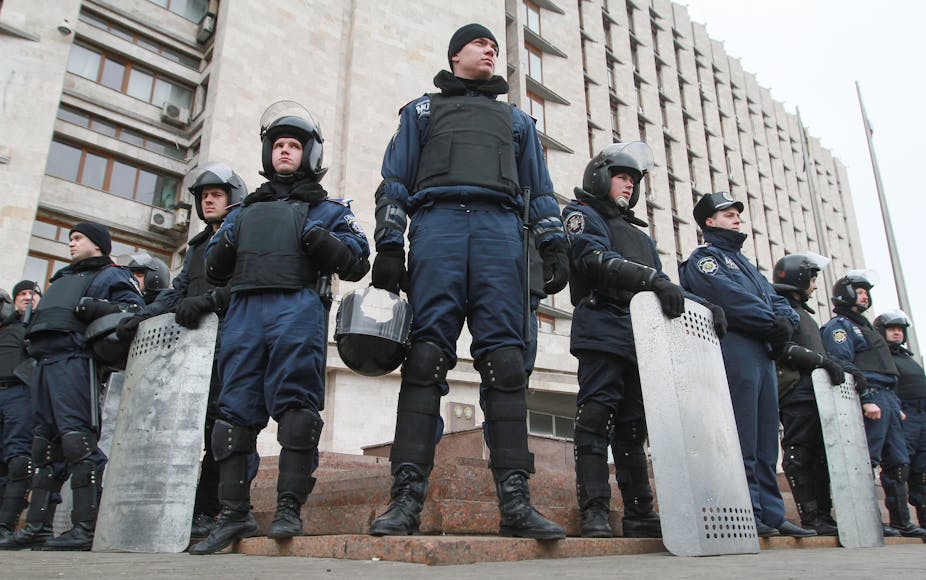Now that Ukraine has lost Crimea, which seems certain to be reunited with the Russian Federation, the future of the remainder of the country depends on what happens in the urban, industrial and populous eastern regions such as the Donbas. Already in recent weeks pro-Russian protesters have at times flown Russian flags over occupied government buildings in Donetsk.
In part, the country’s fate depends on whether a mass movement in favour of greater autonomy within Ukraine and/or closer ties with Russia emerges in large commercial urban centres like Donetsk as well as in the mono-industrial towns which populate the wider region. The kind of mobilisation that occurred in Kiev and the western cities and regions is unlikely to be repeated in the east with its more passive political culture, but it is painfully difficult to judge the balance of public opinion at this febrile time.
An opinion poll conducted by the Democratic Initiatives Foundation (DIF) and the Kiev International Institute of Sociology (KIIS) during the political crisis but before former president Viktor Yanukovych was toppled tells its own story. It found that 33% of respondents in Donetsk region favoured unity with Russia (second only to Crimea with 41%). The figure for the neighbouring region of Luhansk was 24%.
The fall of Yanukovych is certain to have polarised opinion, as it did in Crimea, suggesting that these figures will have increased significantly. Even more popular will be the federalisation of the country as a way to recognise regional autonomy. A recent poll by SOCIS found only 18.3% favoured federalism nationally, but the figures for regions such as Donetsk and Luhansk will be much higher and climbing.
That said, the anti-Maidan movement driven by the “Patriotic Forces of the Donbass” has failed to attract huge numbers of followers. The group, which seeks to pull Ukraine back from closer ties with the European Union and which has emerged in the weeks since the fall of Yanukovych, numbers in the single thousands, even if it has been too large on occasions for the militia to control.
A countervailing pro-unity/peace movement has also emerged in the city, organised by a self-styled “Committee for Patriotic Forces”, which resulted in a standoff between the two sides during which a pro-unity protester was attacked and killed by anti-Maidan protestors last Thursday.
Power game
No less important than what happens on the streets will be the calculations made by the regions’ elites. Of course, what happens in the corridors of political and commercial power in the regions and on the streets is intimately connected.
There is a suspicion that the Party of the Regions of Ukraine (PRU) and associated commercial structures may be professing loyalty to the new authorities in Kiev whilst simultaneously cultivating the anti-Maidan movement. The party, which has now abandoned former leader Yanukovych, is thought to be protecting their interests in the region while making themselves indispensable to the new pro-western revolutionary authorities in Kiev.
Paradoxically, the revolutionaries who unseated Yanukovych, with a little western assistance, depend on there not being an equivalent revolution in the east of the country. A revolution would not only reject the Kiev authorities but also local political and commercial elites, and in these circumstances only Russian interests could benefit. Rather the revolutionaries depend on maintaining traditional centres of power such as the controversial business tycoons like Rinat Akhmetov, Ukraine’s richest man and owner of much of the Donbas’ industrial base, who called for calm after the killing in Donetsk last week.
Social crisis
The role played by the workers’ movement in the Donbas will be decisive. Dormant since 1996, to date the workers’ movement has not been moved to support the anti-maidan, pro-federalist movement in the city. Two factors will determine whether, and how, the working class mobilises.
The first centres on the performance of the economy in the coming months. Should the political crisis turn into an economic crisis, as seems likely, then ordinary workers in the Donbas may once again support calls for greater regional autonomy as they face up to short-time working and wage arrears. Equally, the anticipated public spending cuts across the country and the expected reallocation of public money from the east to the west of the country may trigger a broadly based social crisis in the region.
The second factor revolves around whether the region’s elite remains divided, as it has been in the aftermath of the ousting of Yanukovych, or whether it reunites around claims for greater regional autonomy. A divided elite is unlikely to be able to harness the mobilisation of workers, should it occur – which would result in unpredictable outcomes that could challenge not only the new government in Kiev but also, and crucially, the established power brokers in the region.
The prospect of this suggests that the currently divided elite may reunite, manipulating any mass mobilisation of workers, to protect their political and commercial interests in the region. And it is in these circumstances that demands for the federalisation of the country and even unity with Russia could quickly grow wings and even be the pre-cursor to Kiev losing not only Crimea but also the Donbas.

